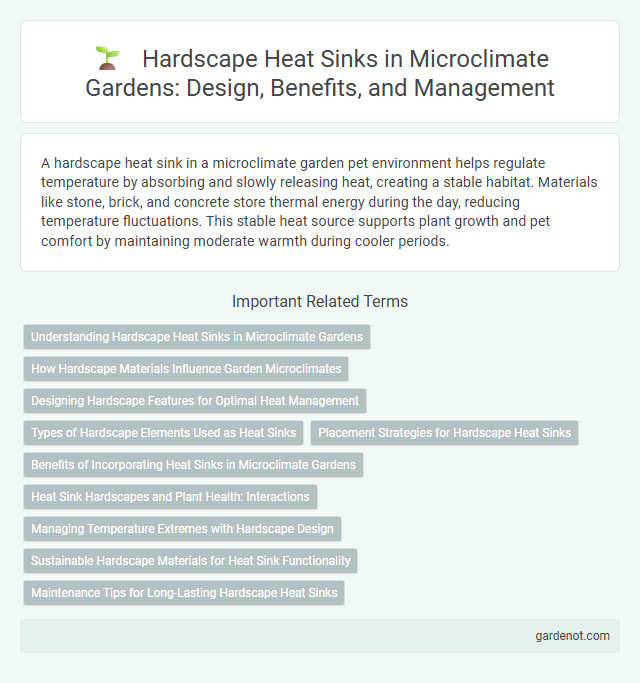A hardscape heat sink in a microclimate garden pet environment helps regulate temperature by absorbing and slowly releasing heat, creating a stable habitat. Materials like stone, brick, and concrete store thermal energy during the day, reducing temperature fluctuations. This stable heat source supports plant growth and pet comfort by maintaining moderate warmth during cooler periods.
Understanding Hardscape Heat Sinks in Microclimate Gardens
Hardscape heat sinks in microclimate gardens refer to materials like stone, concrete, and brick that absorb, store, and radiate heat, significantly impacting local temperature regulation. Understanding their thermal properties helps optimize garden design by strategically placing heat sinks to moderate temperature extremes and enhance plant health. Effective management of hardscape elements balances heat retention and dissipation, promoting a stable microclimate environment conducive to diverse plant growth.
How Hardscape Materials Influence Garden Microclimates
Hardscape materials such as concrete, stone, and brick absorb and retain solar heat, significantly influencing garden microclimates by increasing surrounding air and surface temperatures. These heat sinks moderate temperature fluctuations, creating warmer microenvironments that can extend the growing season for certain plants but may stress heat-sensitive species. Strategic placement and material choice in hardscaping optimize thermal properties, enhancing energy efficiency and microclimate control within garden spaces.
Designing Hardscape Features for Optimal Heat Management
Designing hardscape features for optimal heat management involves selecting materials with high thermal mass, such as natural stone or concrete, which absorb and slowly release heat, moderating temperature fluctuations in a microclimate garden. Incorporating shade structures and permeable surfaces reduces heat buildup, enhancing comfort and plant health by minimizing soil temperature extremes. Strategic placement of reflective or light-colored hardscape elements further mitigates heat absorption, creating a balanced microenvironment that supports sustainable garden ecosystems.
Types of Hardscape Elements Used as Heat Sinks
Hardscape elements such as concrete patios, stone walkways, brick walls, and gravel beds act as effective heat sinks by absorbing and slowly releasing thermal energy, thereby moderating microclimate temperatures. Materials with high thermal mass like dense pavers and natural stone are particularly efficient in storing heat during the day and reducing temperature fluctuations at night. Incorporating these hardscape components strategically can improve outdoor comfort and enhance the microclimate in garden environments.
Placement Strategies for Hardscape Heat Sinks
Strategic placement of hardscape heat sinks in microclimate gardens involves positioning materials like stone or concrete in areas receiving maximum solar exposure to absorb and slowly release heat, enhancing temperature regulation. Locating these elements near patios, seating areas, or plant beds can optimize thermal mass benefits and improve comfort during cooler evenings. Integrating heat sinks along wind-protected zones further minimizes heat loss and stabilizes the garden microclimate effectively.
Benefits of Incorporating Heat Sinks in Microclimate Gardens
Incorporating hardscape heat sinks in microclimate gardens stabilizes temperature fluctuations by absorbing and gradually releasing heat, creating a balanced environment for plants. These thermal masses reduce heat stress on sensitive vegetation, enhancing growth and resilience during hot periods. Heat sinks also contribute to improved microhabitat conditions by moderating humidity and supporting beneficial microbial activity in the soil.
Heat Sink Hardscapes and Plant Health: Interactions
Heat sink hardscapes play a critical role in microclimate garden design by absorbing and storing solar radiation, which influences local temperature variations and impacts plant health. These surfaces can moderate temperature extremes, reducing heat stress on plants, but prolonged heat retention may increase evapotranspiration rates and water demand. Understanding the thermal properties of materials like concrete, stone, and brick allows gardeners to optimize plant placement and irrigation strategies to enhance overall garden resilience and productivity.
Managing Temperature Extremes with Hardscape Design
Hardscape heat sinks regulate microclimate temperatures by absorbing and slowly releasing solar heat, reducing temperature fluctuations in garden spaces. Materials like stone, concrete, and brick are strategically placed to capture daytime heat and prevent rapid cooling at night, creating a stable environment for plants. Effective hardscape design minimizes heat stress on sensitive vegetation and enhances overall garden comfort during temperature extremes.
Sustainable Hardscape Materials for Heat Sink Functionality
Sustainable hardscape materials like permeable pavers, recycled concrete, and natural stone effectively absorb and dissipate heat, reducing urban heat island effects in microclimate gardens. These materials enhance heat sink functionality by improving thermal mass while promoting water infiltration and minimizing environmental impact. Integrating sustainable hardscape components supports cooler microclimates and contributes to long-term garden resilience.
Maintenance Tips for Long-Lasting Hardscape Heat Sinks
Regular cleaning of hardscape heat sinks prevents debris buildup, ensuring efficient heat absorption and dissipation in microclimate gardens. Applying sealants protects surfaces from weathering and extends their lifespan against UV damage and moisture intrusion. Inspecting for cracks or joint damage allows timely repairs, maintaining structural integrity and optimal thermal performance.
Hardscape heat sink Infographic

 gardenot.com
gardenot.com